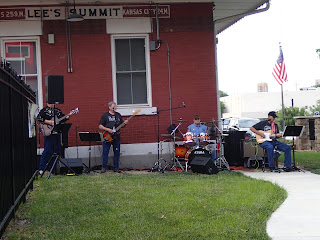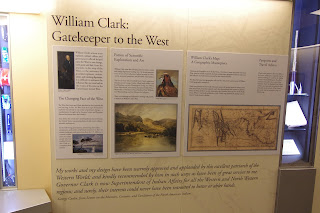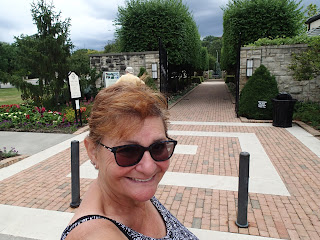June 17-July
8
Jackson
County, Kansas City, MO and other excursions.
Back in December we had to have the
transmission in our truck replaced. We
really lucked out because the transmission died just two weeks shy of the end
of our extended warranty.
Shortly
before arriving in Lee’s Summit Monte noticed we were low on transmission
fluid. Two days after adding fluid it
was low again. He contacted the extended
the transmission company that held the warranty on the new transmission and
they just happen to be located in Lee’s Summit.
CRAZY coincidence!
Long story
short-after having the truck inspected at a shop referred by the warranty
company who found metal flecks in the bottom of the pan, it was determined that
the transmission should be replaced. By
this time we had reached our 14 day limit at the county campground where we
were staying. We were granted an extension.
While we
were in the Jackson County area we did some exploring, attended shows and tried
to keep cool during a heat wave with temps reaching 106 degrees.
We attended
an open house, free to the public, at the local airport where we were treated
to a parade of planes and then an air show.
There were several small private planes on display as well as some
aviation-related booths, food vendors and helicopter rides (for a fee).
Downtown Lee’s
Summit hosts music in the park concerts on Friday nights.
At the B
& B Theatre we tried a new type of movie experience called MX4D while
watching Jurassic World: Fallen Kingdom.
Some of the things we experienced that were synced to the action on the
screen included seat rolls and tilts, wind and water mist. I found the motions to be a distraction and
not worth the extra cost.
Just before the entrance to one of the parks we saw bison at the Native Hooved Animal Enclosure, a 110-acre fenced enclosure that is home to bison, elk and white-tailed deer.



We also
visited two Jackson County Parks offering a glimpse into the past.
Just before the entrance to one of the parks we saw bison at the Native Hooved Animal Enclosure, a 110-acre fenced enclosure that is home to bison, elk and white-tailed deer.

Missouri
Town 1855 is a rustic crossroads village that portrays an antebellum farming
community dating from 1820-1860.
Interpreters
in period attire enhance the experience of this living history museum that
includes furnishings and equipment depicting lifestyles in mid-19th
century Missouri.

Fort Osage
functioned as one of the first military outposts and trade houses in the
Louisiana Purchase.
Under the direction
of William Clark, the fort maintained the political stability in the
region.
The structures were rebuilt
according to documentation from archeological excavations.
Interpreters provide insight into the daily
life of the fort’s civilian and military population in 1812.
Fort Osage Visitor Center
On July 3rd
we were treated to an excellent fireworks display at Legacy Park.
For one of our
excursions into Kansas City we took advantage of the free streetcar as well as
the all day $3 bus pass.
We parked in a garage in the Country Club Plaza area that was free of charge then took the bus to the Crown Plaza District to tour the Hallmark Visitor Center.
We parked in a garage in the Country Club Plaza area that was free of charge then took the bus to the Crown Plaza District to tour the Hallmark Visitor Center.
A short film
tells the story of how a Nebraska teenager tucked two shoeboxes of postcards
under his arms and created an iconic, multi-billion dollar company in Kansas
City.
 The walking tour’s timeline shows
the humble beginnings to becoming one of the world’s largest creative communities.
The walking tour’s timeline shows
the humble beginnings to becoming one of the world’s largest creative communities.
 The walking tour’s timeline shows
the humble beginnings to becoming one of the world’s largest creative communities.
The walking tour’s timeline shows
the humble beginnings to becoming one of the world’s largest creative communities.
Union
Station is a short walk away from the Hallmark Visitor Center. Union Station is at the centerpiece of Kansas
City’s history.
Opened in
1914, the station, at its peak in 1945, served over 670,000 passengers but
declined in the 1950s and was closed in 1985.
A $250
million dollar restoration was completed in 1999. The station today, in addition to an Amtrak
depot, includes a science center, theaters, restaurants and exhibition halls.
 In one hall we toured the Model Rail Exhibit
that features 8,000 square feet of toy trains from tiny Z-scale model trains to
the big G-scale giants.
In one hall we toured the Model Rail Exhibit
that features 8,000 square feet of toy trains from tiny Z-scale model trains to
the big G-scale giants.
 In one hall we toured the Model Rail Exhibit
that features 8,000 square feet of toy trains from tiny Z-scale model trains to
the big G-scale giants.
In one hall we toured the Model Rail Exhibit
that features 8,000 square feet of toy trains from tiny Z-scale model trains to
the big G-scale giants.
The upper
floors of the station, house a museum with a timeline of the station’s history.
We took the
street car to the Central Library Parking Garage in the Downtown area.
Known as the Community Bookshelf, “the book
spines, which measure 25 feet by 9 feet, showcase 22 titles reflecting a wide
variety of reading interests.
A short
distance away is the Ewing and Muriel Kauffman Memorial Garden that draws
inspiration from the couple’s journey through life and their commitment to
share with others.
The garden
features bronze sculptures and colorful annual and perennial plantings framed
by stone walls, brick walkways and playful fountains.
One Exploration took us to Fort Leavenworth, some fifty miles away from the campground where we were staying.
As an active
army installation a visitor pass is required to enter the fort. Obtaining the pass was easy from the Visitor
Center located a short distance from the entry post. After showing our Florida driver’s license and
a short interview explaining our reason for the visit we had our passes.
Built in
1927, Fort Leavenworth is the oldest active Army post west of Washington,
D.C. It is historically known as the “intellectual
Center of the Army.
It was also
the base of African-American soldiers known as Buffalo Soldiers, nicknamed by
Native American tribes.
Fort
Leavenworth was the destination for thousands of soldiers, surveyors, immigrants,
preachers and settlers who passed through during the country’s westward
expansion.
Most of our
time at the fort was spent at the Frontier Army Museum. The main gallery highlights the efforts of
the Frontier Army in exploration, expansion and protection of the
Trans-Mississippi West from the Lewis and Clark Expedition to the chase of
Pancho Villa by John Pershing.

The Beyond Lewis & Clark exhibit explores how the Corps of Discovery surveyed and mapped the American West in search of a passageway to the Pacific in 1804.
Originally known as the United States Military Prison, the USDB was established by Act of Congress in 1874. Prisoners were used for the bulk of the construction, which began in 1875 and was completed in 1921.

We also
visited Fort Scott National Historic Site in Kansas. The purpose of the fort, established in 1842,
was to keep the peace between the settlers and the Native Americans.
We timed our
arrival just right to join a ranger-led tour followed by a small arms
demonstration.
We had only
planned on being in the Kansas City area for one week, but, as most people who
live this crazy lifestyle know, plans change with unforeseen circumstances.
We finally
have our truck back so after 25 days in the same spot we are ready to move on.

























































































No comments:
Post a Comment